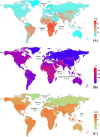Global burden of rheumatic heart disease: trends from 1990 to 2019
- PMID: 35690787
- PMCID: PMC9188068
- DOI: 10.1186/s13075-022-02829-3
Global burden of rheumatic heart disease: trends from 1990 to 2019
Abstract
Background: Rheumatic heart disease (RHD) is a critical public health issue worldwide, and its epidemiological patterns have changed over the decades. This article aimed to estimate the global trends of RHD, and attributable risks from 1990 to 2019.
Methods: Data on RHD burden were explored from the Global Burden of Disease Study 2019. Trends of the RHD burden were estimated using the estimated annual percentage change (EAPC) and age-standardized rate (ASR).
Results: During 1990-2019, increasing trends in the ASR of incidence and prevalence of RHD were observed worldwide, with the respective EAPCs of 0.58 (95% confidence interval [CI] 0.52 to 0.63) and 0.57 (95%CI 0.50 to 0.63). Meanwhile, increasing trends commonly occurred in low and middle Socio-Demographic Index (SDI) regions and countries. The largest increasing trends in the ASR of incidence and prevalence were seen in Fiji, with the respective EAPCs being 2.17 (95%CI 1.48 to 2.86) and 2.22 (95%CI 1.53 to 2.91). However, death and disability-adjusted life years (DALYs) due to RHD showed pronounced decreasing trends of ASR globally, in which the EAPCs were - 2.98 (95%CI - 3.03 to - 2.94) and - 2.70 (95%CI - 2.75 to - 2.65), respectively. Meanwhile, decreasing trends were also observed in all SDI areas and geographic regions. The largest decreasing trends of death were observed in Thailand (EAPC = - 9.55, 95%CI - 10.48 to - 8.61). Among the attributable risks, behavioral risk-related death and DALYs caused by RHD had pronounced decreasing trends worldwide and in SDI areas.
Conclusions: Pronounced decreasing trends of death and DALYs caused by RHD were observed in regions and countries from 1990 to 2019, but the RHD burden remains a substantial challenge globally. The results would inform the strategies for more effective prevention and control of RHD.
Keywords: Age-standardized rate; Disability-adjusted life years; Estimated annual percentage change; Global Burden of Disease; Rheumatic heart disease.
© 2022. The Author(s).
Conflict of interest statement
The authors declare that they have no competing interests.
Figures





References
-
- Zuhlke L, Karthikeyan G, Engel ME, Rangarajan S, Mackie P, Cupido-Katya Mauff B, Islam S, Daniels R, Francis V, Ogendo S, et al. Clinical outcomes in 3343 children and adults with rheumatic heart disease from 14 low- and middle-income countries: two-year follow-up of the Global Rheumatic Heart Disease Registry (the REMEDY Study) Circulation. 2016;134(19):1456–1466. doi: 10.1161/CIRCULATIONAHA.116.024769. - DOI - PubMed
-
- GBD 2013 Mortality Causes of Death Collaborators Global, regional, and national age-sex specific all-cause and cause-specific mortality for 240 causes of death, 1990-2013: a systematic analysis for the Global Burden of Disease Study 2013. Lancet. 2015;385(9963):117–171. doi: 10.1016/S0140-6736(14)61682-2. - DOI - PMC - PubMed
MeSH terms
LinkOut - more resources
Full Text Sources

